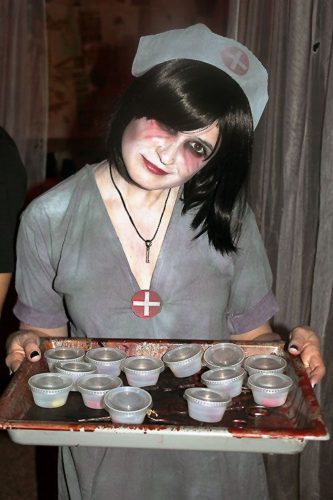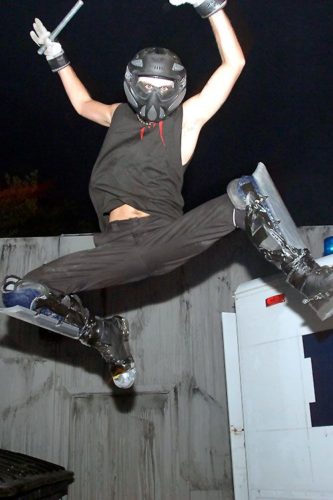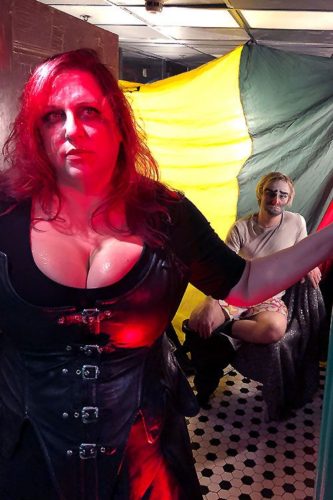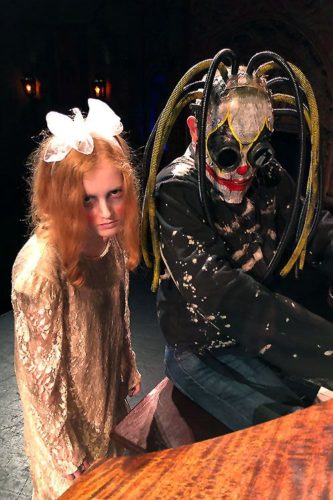We’ve always focused on actor safety, so build on what you already do well to care for them after the pandemic.
By Scott Swenson
We, in the haunt industry, are ahead of the game when it comes to actor safety, and we’re already doing a lot of things right to protect our performers. However, we’re in a particularly challenging time right now in terms of keeping actors safe while still delivering the scares. In this article, I’m going to talk about specific changes we can make to enhance actor—and guest—safety as we emerge from the current pandemic. I don’t have all the answers, but I hope I at least get you thinking about the right questions.
Key takeaways:
- Remember that perception is reality, especially to our guests.
- Take your design concept to the next level.
- Build on what you already do right to protect your actors.
- Provide personal protective equipment.
- Use audio enhancement to maximize the scares.
- Keep costumes clean.
- Pay special attention to makeup.
- Clean your haunt in plain sight.
- Think differently to enhance actor safety.
As I mentioned, we, in the haunt industry, already know how to keep our actors safe. First, we’re able to control actor and guest interaction. We can decide where the guests go, where the actors go, and to what extent they connect and interact. We already know how to do that. Our challenge now is to evaluate how we do that while adhering to the current safety restrictions.
Watch this Session
The video recording of this session is available free on HAuNT Connect.

Perception is Reality
We’re being given the opportunity to look at our industry through a new lens. More than ever, we need to look at our industry from the standpoint of perception, because perception is reality, especially to our guests—the people we’re trying to scare. We have to represent this new perception in a clear and concise way. If guests perceive our haunted attraction isn’t safe, they won’t come back, and, if actors perceive our haunted attraction isn’t safe, they won’t want to work for us. Because of the emphasis on social distancing and disinfecting, we have to instill trust in our actors and our guests that we’re taking care of them. We can no longer operate our haunted attractions the way we have been, at least not in the short term.
Take Your Design Concept to the Next Level
We have to take our design concept to the next level based on current safety concerns. We already know about keeping people six feet apart, but when an actor or a guest screams, they may be expelling all sorts of contaminants into the air. So, we need to find a way to design our haunts so both actors and guests are protected. For example, we can arrange the pathway through our attraction to control the type of interaction that our performers have with guests as well as the distance between them.
One way we’ve been taking care of our performers for years is providing good actor training. I’ve talked to a couple people in the industry, and I don’t think actor training will change a whole lot going forward. If you have an extreme haunt where there’s contact between actors and guests and you immerse people in pig’s blood or whatever, that’s a whole other issue. But, in your standard, basic, haunted attraction, the training has always been to not touch guests.
We used to say, “Make the scare and get outta there.” If an actor was closer to a guest than the length of their arm for more than three seconds, they were too close. Previously, we were more concerned about actors getting hit, and now we’re more concerned about people exchanging a virus, but the “no-touch” maxim pertains to both. So, we’re already in good shape. We may just have to reevaluate and find new and different ways to enhance safety.
We’re masters at creating illusions, and we’re able to create a suspension of disbelief, so our task now is to choose the right illusion. First, we get people involved using story, and then we use our creativity and control to create illusions that are safe.

Build on What You Already Do Right to Protect Your Actors
Some of the things that we already do to protect our actors include providing a safe work environment while creating the illusion of danger. We also encourage actor health. We know that haunt acting is one of those ridiculously difficult jobs where actors not only discover new places to hurt but new ways to hurt themselves. They discover how easy it is to forget to drink enough water. We want to make sure that, just like we did with hydration for years, we provide each actor with a personal water bottle and hand sanitizer and remind them, every time they go on break, not only to drink plenty of water but to wash or sanitize their hands.
We need to make sure that when our actors are in the back areas of the haunt, they have access to hand sanitizer, at least, if not running water and soap. This needs to be part of the training you give them: Wash your hands, cover your mouth and nose when you cough or sneeze, and keep your hands to yourself. These are things we can do now and reinforce with our staff repeatedly.
I suggest including these basics as part of your auditions as well. When people walk into the audition area, have someone there to squirt hand sanitizer on their hands. In this way, your actions speak far louder than your words. Another option is to do more video casting. You may need to have people make tapes of themselves. This is often done in commercial and film work. The actor is given something to do, which they record themselves doing and send the video to you. Obviously, you’ll want to talk to them in person at some point, but this is a great way to screen people to find your best candidates.
Provide Personal Protective Equipment
In every haunt I’ve ever worked in, if any of the actors requested something like earplugs or knee pads or shin guards or face guards, it was our responsibility to provide them. We’re now at the next level of that—providing the right personal protective equipment. Of course, we don’t know yet what that will be by the time Fall rolls around. Still, this is nothing new to us. We’re already experts in the basic concepts of protecting our actors.
A great strategy is to incorporate personal protective equipment in your costume design. Any time you can include personal protective equipment in the costume design, you’re three steps ahead. Figure out how to incorporate personal protective equipment that will keep your actors and your guests safe, and work that into your theme or story.

Use Audio Enhancement to Maximize the Scares
Haunt actors love to get right up in people’s faces to scare them, but, in this day and age, we may need to find new and different ways to scare that incorporate additional distance between actor and guest. How do we do this and keep the scare going? One option might be to compensate by adding additional audio. I love audio triggers that reinforce an actor’s scare. This works well for actors that are behind drop doors or are even out and about. Give them a foot trigger that activates a recorded sound effect, whether that be a giant scream or, one of my favorites, the crash of a glass window breaking behind a drop door. You make the drop door look like a window and, when it falls, you have the sound of smashing glass. This works amazingly well, and you can do it with a simple foot trigger or a proximity switch.
Sound enhancement doesn’t necessarily have to be recorded audio. You can use noisemakers like horns or whatever. Using this kind of audio also saves the actors’ voices. Although I’m not a doctor, it seems that if an actor is screaming so much that it wears out their voice, this might eventually affect their immune system.
Another way to compensate for the increased distance between actor and guest is to give the actors hand props, which make the performer appear larger than they actually are. Give them something that’s safe but creates the illusion of being threatening. If that hand prop makes a noise, that’s even better.

Keep Costumes Clean
One of my biggest pet peeves is costumes that can’t be effectively cleaned. I understand that there are certain things that can’t be thrown into the washer, but, going forward, we must look at creating costumes that can be easily and thoroughly cleaned to protect the health of our actors.
Obviously, the first line of defense is for the actor to wear something underneath a particular costume, but it’s still essential that costumes not be shared without being cleaned between each wearer. Even if the same actor wears the costume all the time, make sure it’s cleaned on a regular basis. If your actors finish up at two o’clock in the morning and need to be back in costume at six o’clock the following night, do you have the time and resources to launder 200 costumes? You might have to hire a laundry or agency to clean your costumes daily, or you could build multiple costumes, so you have a full 24 hours to launder one set while the other set is being used. Both of these options might be somewhat expensive, but they’re cheaper than a lawsuit.
Pay Special Attention to Makeup
Making certain that your makeup supplies are clean or, even better, personalized to each actor is really important. Many theme parks train their actors to do their own makeup, and each actor is given a makeup kit that’s theirs until the end of the run. This is a bit more expensive, but it’s a great way to make sure your actors aren’t sharing makeup and the implements to apply it.

Clean Your Haunt in Plain Sight
Let guests see that you’re cleaning, because this will make them feel you really do care. It shows that you’re taking the appropriate actions and being responsible. I’m not saying to clean in front of people all the time, but it’s okay to be seen wiping down handrails and other items in guest areas. And don’t forget to regularly clean your backstage area as well. Especially now, we need to treat our actors and our guests well, because the way we treat people will be remembered, and that affects our brand.
Think Differently to Enhance Actor Safety
The current pandemic is requiring us to think differently about how we keep our actors safe while continuing to scare our guests at the same level we always have. One option might be to incorporate video and virtual elements—for example, video monitors behind drop doors. When a drop door falls, instead of an actor standing there, there’s a video monitor that has a transformative something going on. By combining that with an actual physical effect, this could be a way to keep actors safer. Another thing that might be fun is to put some of those video effects behind wooden slats. Guests wouldn’t be able to see them completely, and you could give the impression of rats climbing behind the walls or eyes peeking out or a monster charging up against the wall. If you did the latter, you could have a live actor smack the wall on either side of the video monitor.
We now have a great opportunity to think differently—not just to create safe environments for our actors but to come up with exciting new ideas for our haunts.

